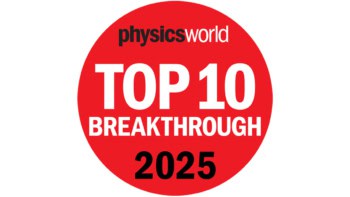Do you have a new physics joke, a fresh form of physics wit, or an example of unexpected humour that gets you thinking? If so, Robert P Crease wants to hear from you
Q: Why won’t Heisenberg’s operators live in the suburbs?
A: They don’t commute.
Q: What do you get if you cross a pig with a rat?
A: Pig rat sine theta.
So this neutron walks into a bar, orders a pint of lager and begins to open his wallet when the barman says, “For you, no charge!”.
These jokes may make you laugh, grimace or groan – but they may also inspire you to wonder about the raw material for humour in physics, which may not be obvious at first glance. Where are the wordplays, repressed desires and bodily functions that normally propel jokes? The sex, aggression and death?
Close inspection, however, reveals uncanny similarities between physics and humour. Both, for instance, prize invention and the unexpected. Small wonder, then, that practising physicists find the field alive with wit, jokes, and laughter.
Things that make you go ha ha…
Much physics laughter takes standard forms, including cartoons, spoofs, limericks and one-liners. Many have been explored in the “Zero Gravity” column in the American Physical Society’s monthly newsletter. These have included physics product warnings (“This product warps space and time in its vicinity”), pick-up lines (“I want you to diagonalize my inertia tensor”) and jokes contrasting the various reactions of different professionals to the same situation.
The latter, which might be called “trio” jokes, often contrast the actions of a physicist with those of an engineer, who is eminently practical, and a mathematician, who is wholly impractical. The physicist usually comes off as being abstract but partly practical – but as wholly impractical when a farmer or carpenter replaces the mathematician, and poor-but-virtuous when the other two companions are an accountant and a lawyer.
A physics-limerick contest in the Zero Gravity column produced almost 200 entries. The best entries to a slogan contest were turned into badges, including: “Flirt harder, I’m a physicist”, “Know a good quantum mechanic?” and “Don’t drink and derive”. One, written in white lettering on a red background, became a bumper sticker: “If this sticker looks blue, you are driving too fast.”
The above material either belongs to a stock genre or has been around a while. Still, a well told joke is a treasure, however well worn or old, and enough new material keeps cropping up to satisfy physicists.
…or ha ha and then hmm
A different sort of humour in science – including physics – has been featured for the past 12 years at the annual Ig Nobel ceremony. Sponsored by the Annals of Improbable Research, the event takes place every October at Harvard University. The ceremony includes a mini-opera, a “Win a date with a Nobel laureate” contest, and so much paper airplane flying that, to keep the event moving, the organizers recruit someone whose job it is to clear the projectiles from the stage.
The highlight of the ceremony are the Ig Nobel awards themselves. These celebrate what the journal’s editor Marc Abrahams calls “found humour” in science – analogously to “found art”, or things stumbled across unexpectedly. Found humour, then, does not mean jokes. “It is”, says Abrahams, “about things that, when you hear about them, first make you laugh, then make you think.” It also often inspires one to check out the original research, whether out of intrigue or incredulity (see “Ig Nobels prove to be more than a joke” Physics World April 2003 p12).
The 2001 Ig Nobel prize for medicine, for example, was awarded to Peter Barss for his study of “injuries due to falling coconuts”. Barss carried out his study after noticing that a full 2.5% of trauma admissions to his hospital in Papua New Guinea were coconut-related (1984 Journal of Trauma 21 990-1). Coconuts can weigh as much as 4 kg and are formidable projectiles when they fall from treetops. Some victims, sustaining a force to the head of 1000 N, have required craniotomy, while others have died. Quite a few of the victims were highlanders, who had little experience with coconut trees and had chosen to sleep beneath the pleasant-looking palms while visiting relatives on the coast.
Meanwhile, Michael Berry from Bristol University shared the 2000 physics prize with Andre Geim, who was then at the University of Nijmegen, for “using magnets to levitate a frog” (1997 Eur. J. Phys. 18 307). Another physicist to have won a prize is Arnd Leike of the Ludwig Maximilians University in Munich, who showed that the height of beer froth in a glass decays exponentially (2002 Eur. J. Phys. 23 21).
The kind of humour on display at the Ig Nobel ceremonies is, I think, distinctive to science. Making sense of the world requires entering an arena in which the fanciful and the factual, the ridiculous and the true can often be momentarily indistinguishable. With such material, who needs bodily functions?
The critical point
When it comes to laughing at themselves, at each other, and at their field, physicists are as hearty and possess as advanced a sense of humour as anyone else. And I suspect that many of you are sitting on even better material than I have included here.
Do you have a new physics joke, a fresh form of physics wit, or a case of “found humour” in physics? I will describe the results of your contributions in a forthcoming column and send the person with the best entry in each category a copy of my forthcoming book, The Prism and the Pendulum: The Ten Most Beautiful Experiments in Science. The book is about the list I drew up based on responses to my readers’ poll last year (Physics World May 2002 p17; September 2002 pp19-20). I’ll also pass on good examples of found humour to the Ig Nobel committee.
Who knows – you may be a contender.
• New jokes, fresh forms of physics wit and examples of “found humour” in physics – plus any thoughts you have on why physics humour is distinctive – should be sent to Robert P Crease at the address or e-mail given below, or by fax to +1 631 632 7522




